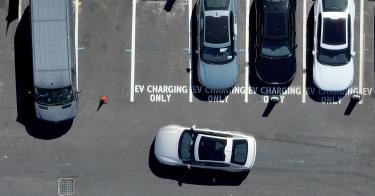While President Joe Biden enjoys his beautiful gas-guzzling 1967 Corvette Stingray, he wants to dictate what kind of car you get to own.
The Environmental Protection Agency’s proposed de facto electric vehicle mandate would force auto manufacturers to make nearly 70% of their new automobiles electric by 2032. Now, Biden’s Department of Transportation is following up with a second punch. On the Friday before Congress’s August recess, when members were leaving town, DOT released a new, expensive, and likely unattainable fuel economy standards proposal requiring passenger cars to meet a standard of 66 miles per gallon and light trucks to reach 54 miles per gallon by 2032.
This new burden being foisted on the auto industry, working-class Americans, and small businesses is being perpetrated in the name of stopping climate change, a top priority of the Biden administration that is being zealously pursued regardless of how it will hurt Americans and how little of an impact their extreme proposals will have on the climate.
According to The Heritage Foundation’s chief statistician, Kevin Dayaratna, if the United States were to eliminate not some, not most, but all of its conventional fuel use, we could expect a less than 0.2-degree Celsius reduction in global temperature by the year 2100. Thus, despite claims that the global environment will collapse within the next decade, leading to a possible “human extinction event” unless the most drastic measures are taken, this onerous regulation will have no environmental benefit and wreak plenty of economic havoc across the nation.
Just as with the Biden regime’s proposed efficiency standards on dishwashers, gas stoves, and water heaters, DOT makes the argument that such restrictive fuel economy standards will save Americans money even though it openly admits “consumers would pay more for new vehicles upfront.” It claims the difference can be made up over time through savings at the gas pump. But the more likely result, when Biden’s overall climate agenda is factored in, is higher auto and gas prices, less consumer choice, and reduced road safety.
As DOT argues, at face value, a higher miles per gallon standard does mean fuel can be stretched further. But when Biden says, “I guarantee you, we’re going to end fossil fuel,” add that to shutting down oil pipelines while draining the nation’s strategic petroleum reserves, and investors become reluctant to spend, energy supply contracts, and fuel prices rise. Thus, while the fuel in these new cars’ tanks might go further, if it costs more, then it cancels out the efficiency savings.
As with the EPA’s proposed tailpipe emissions rule intended to convert much of America over to EVs, the new DOT fuel economy standards mean less consumer choice. Such high fuel standards are extremely difficult to achieve and are unlikely to be attained, meaning that if this rule were to be finalized as is, auto manufacturers will be constrained in what types of vehicles they can build.
Auto companies will be forced to produce more EVs, even if Americans don’t want to buy them. These cars will be more expensive, take longer to recharge than a simple gas fill-up, and will not work as well in very cold or very hot climates. They likely will have reduced functional versatility, such as not possessing any real towing capacity, meaning consumers will be paying more for cars that do less.
Lastly, these fuel economy standards will reduce passenger safety. Per DOT’s own admission noted above, the expected increase in auto prices would make purchasing a new car prohibitively expensive for many Americans.
With unaffordable newer models, consumers lose access to the latest advancements in safety technology. As Americans work to keep their old cars on the road longer and odometers tick up, the law of averages dictates that parts will fail, which not only results in costly repairs, but sadly, can lead to serious car accidents, as older models are shown to be less safe in accidents relative to new vehicles.
According to Heritage Foundation Distinguished Fellow Steve Bradbury:
NHTSA [the DOT’s National Highway Traffic Safety Administration] acknowledges that its proposed fuel economy standards will increase deaths and serious injuries on America’s highways, though the number of additional deaths and injuries NHTSA is estimating in this rulemaking are suspiciously small and almost certainly manipulated to appear less shocking than they really are.
Instead of pursuing a misguided climate agenda that will have negligible global environmental outcomes, the Biden administration ought to be looking at lowering barriers it has imposed on oil drilling, reducing gas prices, and scaling down burdensome regulations.
The DOT’s latest fuel economy standards, especially when considered in conjunction with the EPA’s tailpipe rule, should be rejected. Of equal importance, it is long past due for the central planners in Washington, D.C., to leave drivers alone.
This piece originally appeared in The Daily Signal




